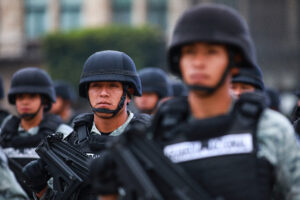By Maureen Meyer and Clay Boggs
Yet again, a journalist’s death provides an alarming illustration of the threats and violence faced by reporters and human rights activists in Mexico. The murder of Ruben Espinosa, a photo-journalist whose coverage of social issues in the State of Veracruz earned him the ire of state officials, also raises serious questions about the disturbing pattern of homicides of journalists in Mexico, particularly those in Veracruz.
In recent years, Veracruz has become particularly deadly for journalists: four of the seven journalists killed this year were from that state; and 13 journalists from Veracruz have been killed since Governor Javier Duarte took office in 2010. According to Mexico’s Special Prosecutor for Crimes against Freedom of Expression (Fiscalía Especial para la Atención de Delitos Cometidos contra la Libertad de Expresión, FEADLE), 43 journalists were killed in all of Mexico between 2010 and 2014. The Committee to Protect Journalists, which makes determinations about whether journalists are killed for reasons related to their work, has already confirmed motives for the killing of two journalists from Veracruz this year. Armando Saldaña Morales of “La Ke Buena 100.9 FM” was killed between May 2 and May 4, just across the border between Oaxaca and Veracruz (he lived and worked in Veracruz). Saldaña Morales had reported on the involvement of organized crime in the theft of petroleum from pipelines. José Moisés Sánchez Cerezo of La Unión was killed on January 2; his body was found decapitated and dismembered. He had frequently denounced criminal activity and criticized local officials, particularly the local mayor, Omar Cruz Reyes, as well as Governor Duarte. The state attorney general has indicated that Mayor Cruz may have been involved.
This pattern seems to have continued with the July 31 discovery of the bodies of five young people who had been brutally murdered in a middle-class neighborhood in Mexico City. One of the victims was Ruben Espinosa. He had worked for two leading Mexican news magazines, Proceso and Cuartoscuro. Espinosa had covered social movements and human rights in Veracruz and denounced attacks against and harassment of journalists in that state, often by state officials. As a result he became a victim of harassment and attacks himself. In June 2015, Espinosa fled Veracruz, seeking out safe haven in Mexico City.
This murder, which included the killing of three women who lived in the apartment, as well as a female housekeeper, is being covered extensively in Mexican news media and has added new fuel to the growing popular discontent in Mexico. Thousands of Mexicans have taken to the streets to protest his killing and the near-total impunity for attacks against journalists in the country. Activists, journalists, and analysts have taken to Twitter en masse, calling for an investigation into Espinosa’s death with the hashtag #JusticiaParaRuben.
The killing is a harrowing reminder of the threats to freedom of expression in Mexico. Mexico is one of the most dangerous countries in the Americas to practice journalism: 102 journalists were killed between 2000 and 2014, according to FEADALE. The same agency reports that 24 journalists were disappeared during the same period.
Furthermore, the government of Mexico has failed to provide journalists with effective protection from threats. In 2012, a successful campaign led by journalists and human rights defenders led to the creation of the Mechanism to Protect Human Rights Defenders and Journalists (Mecanismo de Protección para Personas Defensoras de Derechos Humanos y Periodistas). This Mechanism has received support from the United States government and from the outgoing U.S. ambassador in Mexico, Anthony Wayne. In February 2015, WOLA and Peace Brigades International documented the many ways in which the Mechanism has fallen far short of its mandate to provide urgent protection to defenders and journalists who find themselves at risk. Its shortcomings are many. Turnover in staff and leadership has been frequent; funding is inefficient; protective measures are often ineffective; and state and local authorities are often uncooperative.
A new report by NGOs who participate in oversight of the Mechanism (Espacio OSC), released on July 28, 2015, further underscores the Mechanism’s weakness. This report, the Second Assessment of the Implementation of the Mechanism for the Protection of Human Rights Defenders and Journalists (2º Diagnóstico sobre la Implementación del Mecanismo Federal de Protección a Personas Defensoras de Derechos Humanos y Periodistas) analyzed 59 cases under the Mechanism, finding that the mechanism suffers from a persistent lack of resources, personnel, and political support.
The result of this widespread violence against journalism is a growing self-censorship that raises troubling questions about the freedom of press in Mexico. As Dallas Morning News Mexico City Bureau Chief Alfredo Corchado said at a hearing before the U.S. Congress on July 28, “Today, there are regions in Mexico where reporters have elected to censor themselves. In other words, see nothing, say nothing. These are known as regions of silence.”
Improvements in short-term protection measures for journalists are urgently needed, but such measures must also be accompanied by effective investigations. Whether because of a lack of will or lack of capacity, the government of Mexico has failed to investigate threats against journalists: the Committee to Protect Journalists reports that only 10 percent of murders of journalists since 1992 have resulted in a conviction. According to Mexico’s National Human Rights Commission (Comisión Nacional de los Derechos Humanos, CNDH), in 2013 the perpetrators in 89 percent of the cases of murders and disappearances of journalists were never investigated or sanctioned. Unless the Mexican government steps up its efforts to protect journalists and prosecute those responsible for these crimes, its stated commitment to freedom of expression is mere rhetoric in the face of an appalling reality of murders and attacks against journalists in the country.


